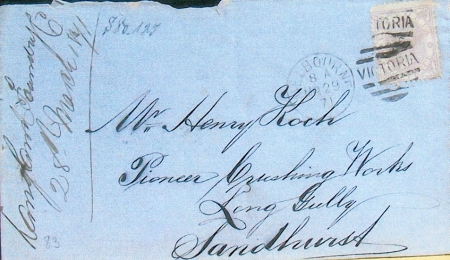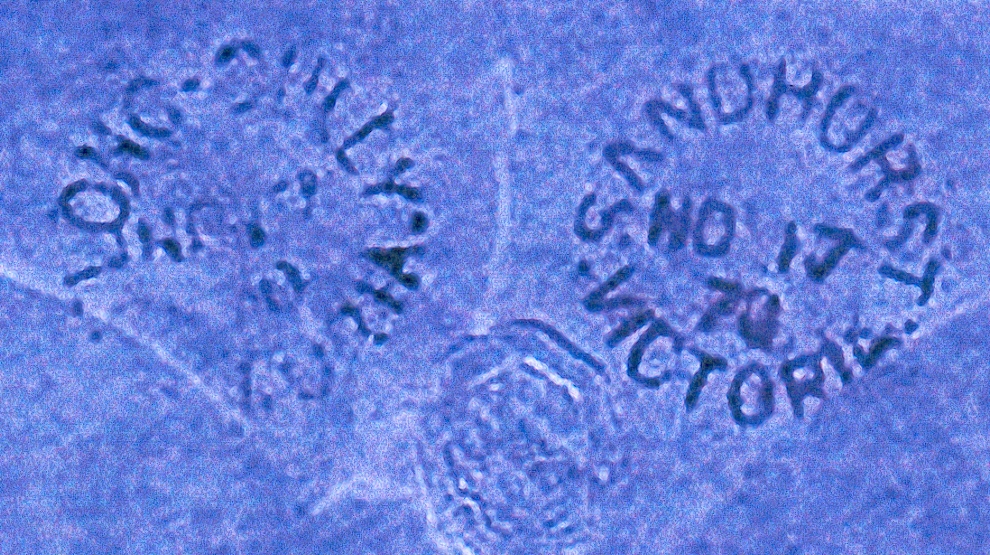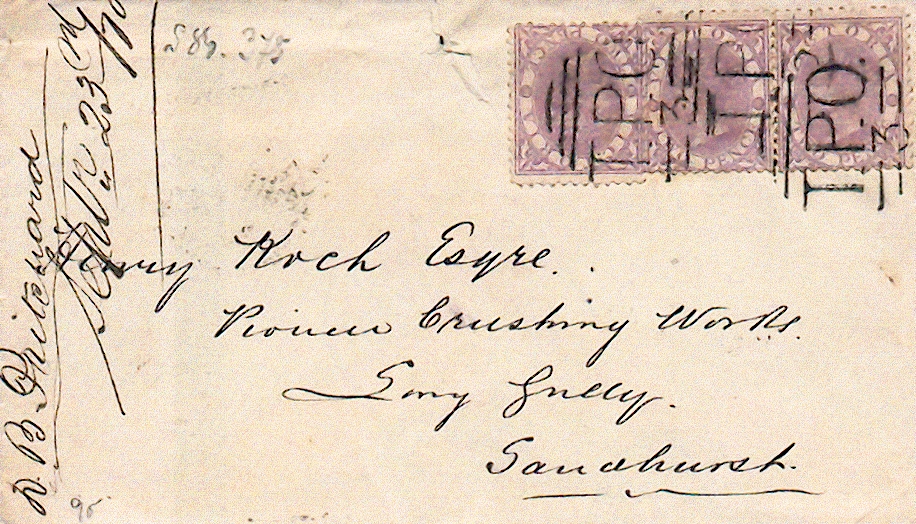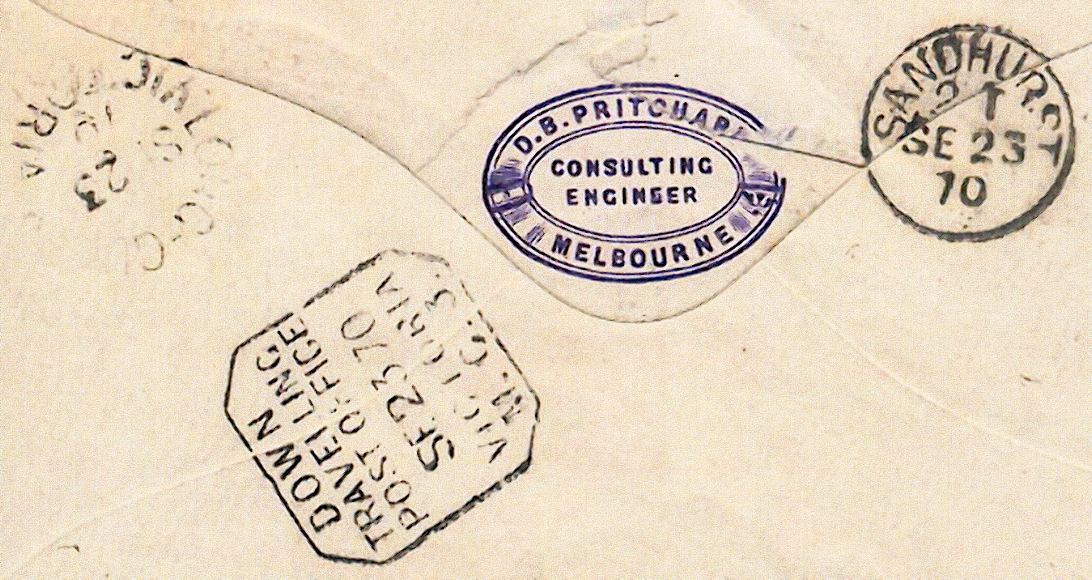The cover is addressed to Mr. Henry Koch, Pioneer Crushing Works, Long Gully, Sandhurst and the vertically placed manuscript identifies the sender as Langlands Foundry Co., and the date of the letter as 28th March 1871. The lilac TWO PENCE Victoria stamp is cancelled with a MELBOURNE/ 8A/ MR 29/ 71 duplex (Figure 1).

The reverse has an incomplete transit postmark of an unframed LONG GULLY/ MR 29/ ( )/ VICTORIA and a reception postmark of SANDHURST/ 2 ( )/ MR 29/ 71. The red ‘belt & buckle’ insignia confirms that the sender is LANGLANDS FOUNDRY COMPANY LIMITED/ MELBOURNE (Figure 2).
Sandhurst later became the major city of Bendigo whereas Long Gully is now an impoverished town. The census collector of 1871 (the year the letter was sent) described Long Valley as a mining settlement, and he stated it as having only16 dwellings and a population of 54. At the height of the Victorian gold rush it was a postal and money order township, a part of the city of Bendigo. It had some institutions of its own, a mechanics’ institute with library of 1,780 volumes, a State school (No. 2,129), Methodist and Bible Christian chapels, seven hotels and a fire brigade (found in Shippers Guide to Australia 1885, page 374) .
The internet gave very sparse information concerning Henry Koch who became rich from the goldmines, whereas most goldminers toiled hard in the bowels of the earth in poor working conditions for low pay. The ground around Bendigo was worked as early as 1853, the area was cut up into a multiplicity of small claims. In the early sixties Mr. Henry Koch had a claim and from his gold profits he formed a battery, known as Koch’s Pioneer Battery. A map showing the relationship of Long Valley (red arrow) to Bendigo (red balloon) is seen in Figure 3.
Henry Langlands’ company sent this cover to Koch but this was after Langlands’ death in 1863. He was an iron founder and politician, who was born in London, a son of John Langlands, baker, of Dundee, and his wife Christian, née Thoms. Henry left school at an early age to apprentice to a linen draper, and at 21 in Glasgow, he became a traveller and eventually a partner of the business. During a thirty-year residence in this city he married three times: his first wife, Jessie Wilson, bore him one child; his second, Caroline Inches, added another five; and, the third marriage, to Janet Mitchell, was childless. He was also an active city politician and achieved some prominence as an opponent of slavery and protagonist of Catholic emancipation.
Langlands, his wife and five surviving children left Scotland in 1846 to join his brother Robert, who with the help of another Scot, established the first foundry at Port Phillip some four years earlier. By the time Henry arrived in early January 1847 the partnership had dissolved and the two brothers took over its ownership. Several years later Robert retired and Henry became the sole proprietor. The foundry prospered for the products were of such high quality, castings for buildings, ornamental iron-work, wool presses, agricultural implements and mining machinery, that they competed successfully with imported articles. By the time of Henry’s retirement, and shortly before his death, Henry Langlands was one of the largest employers in the colony. His men were the first in the colony to cast a bell, and lamp-posts; they cast the boiler of the first train to run in Australia and they successfully launched the first cast-iron vessel.
After six years in the colony Langlands stood for the Legislative Council, was narrowly defeated, but returned on a recount, only to be ousted from office some months later when the displaced F. J. Sargood successfully challenged the returns. The Argus, the champion of democracy, branded Langlands a moderate advocating ‘half measures’. When he was returned as the fifth city representative to the Legislative Assembly of 1856, its contention was proved correct, for Langlands soon identified himself with a group of Nonconformists who were more concerned with the abolition of state aid to religion and with education reform than with democracy.
Langlands died at his home at Jolimont, Victoria on 21 June 1863, and the business was carried on by his sons. A hard-working but unspectacular politician, his main claim to recognition lies in the foundry and his persistent interest in every phase of colonial life. He was a generous supporter of charitable organizations, religious societies and temperance movements.
An email to the Goldfields Research Centre for help ‘to put flesh on Henry Koch’s bones’ drew an immediate response, and a package of photostats arrived in the mail. What follows is a summary of extensive data of research performed by a local historian, James Lerk who published his work from 2004-2008 in the Bendigo Weekly. Heinrich (Henry) Koch was probably born on 16 Apil1832, a son of Klaus Koch, a boat skipper. The family came from Wischaven near Hanover and Henry trained as a professional seaman. His home port was Hamburg and he sailed the world, which took him to Australia in 1851 or 1852. He took leave from his ship Euphrasia to join the rush to the interior in the hope of finding gold, and he was one of the early arrivals at Bendigo. A carte de visite for Henry as a sailor, probably at the age of ca. 19 is seen in Figure 4.
He commenced in alluvial diggings amongst many other Germans and he was soon to realise that the alluvial claims would have only a limited life, so he began to explore and exploit the deeper quartz reefs, often with fellow Germans. There were a number of actively worked leases that Koch owned in Long Gully. He had diverse interests in numerous leases, most of which were worked by others in his employ. He realised that efficient recovery of gold from the quartz rock was the way to success and he became a self-taught quartz crusher with good management and adoption of the latest technology. Not only did he crush his own and partner’s quartz leases, but also for other third party leases. He recognised the need for water so he instituted a series of dams to collect and recycle water, and Long Gully was particularly suited for this purpose.
Koch had an interest in many mining leases in early Bendigo, but he was best known for Koch’s Pioneer Mine which produced over 4 tonnes of gold, and the final shaft depth was at 808 metres. It was first worked in 1857 but some 13 years later with the deeper ground opened up, the reef came in to its own. The view of the interior of his Pioneer Crushing Works was very impressive and was the most extensive plant for ore treatment in the Borough of Sandhurst. The massive machinery equipment was produced locally and there was no mention of his use of the expertise of Henry Langlands foundry to provide equipment. A picture of the interior of the crushing works is seen in Figure 5.
Koch lacked a home and he called in a firm of 2 German expatriate architects in 1870 and the home was ready for his wife Maria and the family, but they did not have much time to enjoy it for during 1871 Koch put the Pioneer Crushing Works up for sale at £75,000 (to-day’s equivalent of $8 million. The reasons for this sale were multiple and complex, and Koch with his family returned to Germany. A picture of an older and prosperous Koch is seen in Figure 6.
The Koch family settled in the Hanseatic City of Lubeck on the edge of the Baltic Sea and he entered the ship building business where he soon established the only shipbuilding wharf for metal ships and built steam dredges amongst other types of vessels at Lubecker Machinen Bangeselschaft, completing a lot of work for the navy, and also for railway contracts. When Henry died in 1888, two of his sons Willy and Franz took over the management of the shipyard, which remained a family business until 1908.
Addendum (August 2009): An additional cover has come available addressed to Henry Koch Esq, Pioneer Works, Long Gully, Sandhurst sent from MELBOURNE/ 2 X/ NO 16/ 70 and the reverse has Long Gully and Sandhurst cancels for NO 17/ 70 (Figures 7 & 8).

I am always amazed where research on a cover might take one, as well as how much trouble librarians will take in providing information for an unknown person living at such distance from them. Leanne Wagner (Goldfields Research Centre, Bendigo) by her rapid response to my email and the quantity and quality of that response, rates very highly as a great provider of information. As already mentioned, the information on Henry Langlands was extracted from the Australian Dictionary of Biography.
Addendum (August 2009): Another cover became available addressed to Koch at his usual address, and the name of D.B. Pritchard & September 23, 1870 have been added as a ms. A strip of 3 lilac ‘TWO PENCE’ stamps of Victoria have been cancelled with T.P.O./ 3 (Figure 9).

The reverse has a purple oval on the flap with D.B. PRITCHARD/ CONSULTING ENGINEER/ MELBOURNE, a boxed DOWN/ TRAVELLING/ POST OFFICE/ SE 23 70/ VICTORIA/ M.G. 3 postmark, a transit SANDHURST/ 2 T/ SE 23 /70, and an arrival LONG GULLY/ SE 23/ 70/ VICTORIA (Figure 10).
